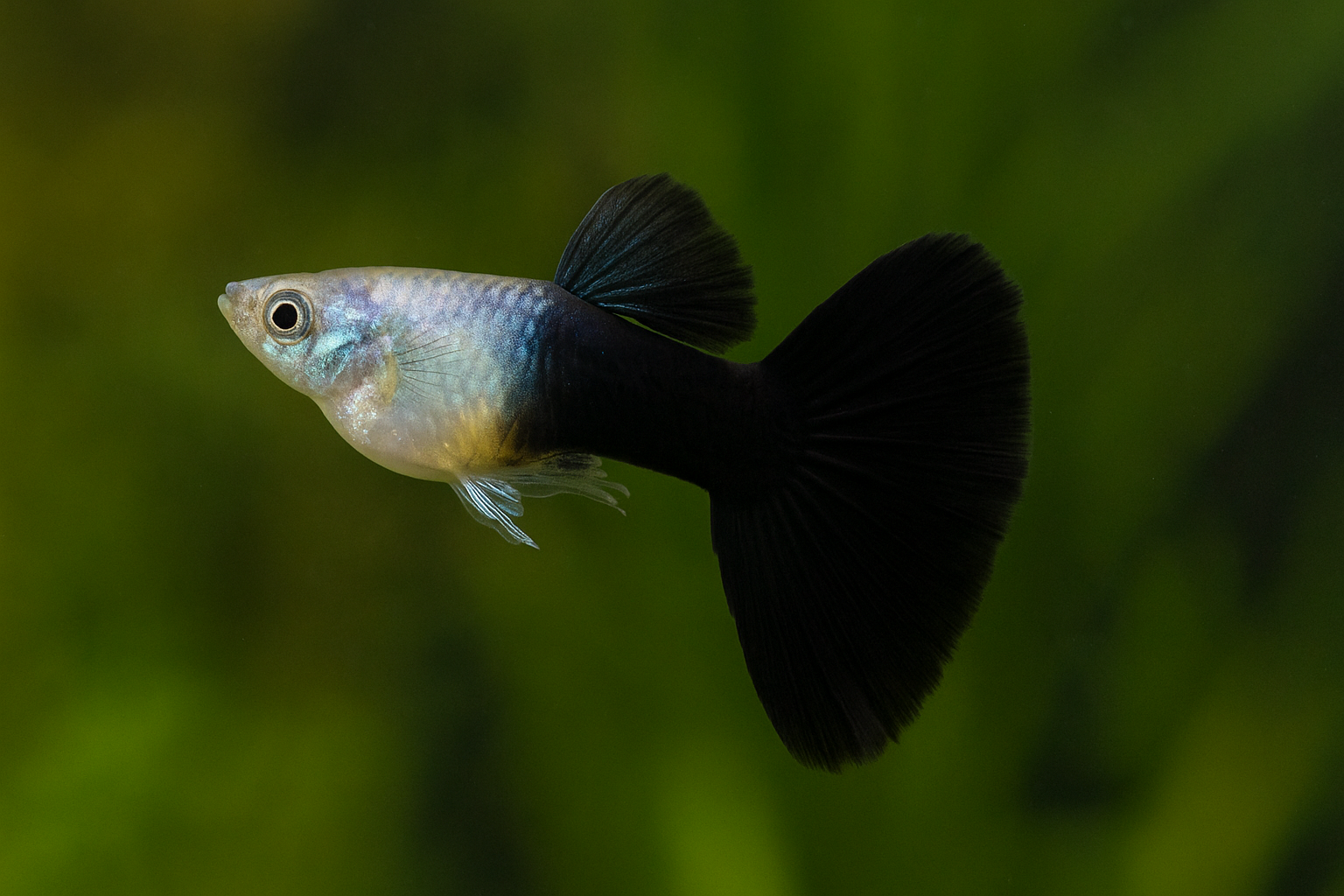The Half Black Guppy is one of the most elegant and visually striking guppy varieties in the aquarium hobby. Known for its unique color pattern—where the front half of its body is brightly colored or metallic, while the rear half is a rich, velvety black—this guppy is a true showstopper in any tank. Whether you are a beginner or an experienced fish keeper, Half Black Guppies are a rewarding choice due to their vibrant appearance, active personality, and ease of care.
In this detailed guide, we’ll cover everything you need to know about Half Black Guppies, including their origin, physical characteristics, tank setup, diet, breeding tips, common health issues, and more.
1. Overview of the Half Black Guppy
- Scientific Name: Poecilia reticulata
- Common Name: Half Black Guppy, HB Guppy
- Family: Poeciliidae
- Origin: Selectively bred in captivity (descended from wild guppies found in South America)
- Lifespan: 2–3 years
- Size: Males 1.5–2 inches; Females 2–2.5 inches
- Temperament: Peaceful, social, active
- Care Level: Easy
The Half Black Guppy is not a naturally occurring wild species but a selectively bred ornamental fish. Its signature look comes from specialized breeding techniques that emphasize a solid black tail and posterior body with a contrasting light or metallic front half.
2. Physical Appearance
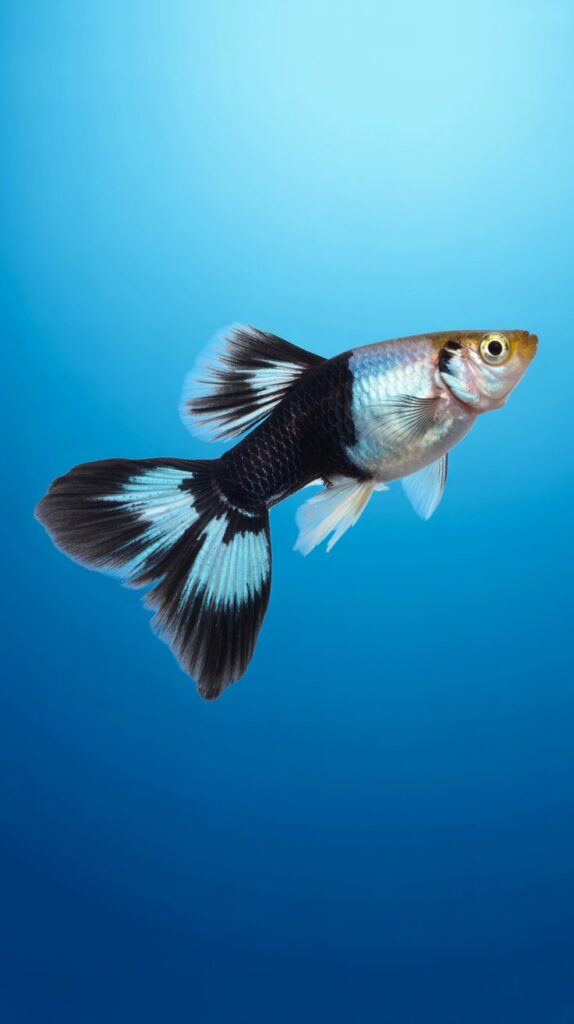
Half Black Guppies are prized for their sharp contrast in color. The front half of the body can range from silver, white, yellow, or even bright neon colors, while the back half is deep black.
Key Features:
- Body Shape: Slender, with a graceful curve from head to tail.
- Tail: May be fan-shaped (delta), lyre-tailed, round, or even sword-shaped, depending on the variety.
- Fins: Often transparent at the base with the black color extending through the tail.
- Color Variants:
- Half Black Red
- Half Black Yellow
- Half Black White
- Half Black Blue
- Half Black Green
- Half Black Pastel
3. Types of Half Black Guppies
There are several sub-varieties, each with its own charm:
a) Half Black Red Guppy
Bright red on the front half and deep black on the back, creating a bold, eye-catching contrast.
b) Half Black Yellow Guppy
Golden-yellow front and velvety black rear, popular among breeders.
c) Half Black Blue Guppy
Shimmering metallic blue in the front half, fading into jet black at the tail.
d) Half Black Pastel Guppy
Soft pastel hues in the front half, perfect for a more delicate aquarium look.
4. Natural Behavior
Half Black Guppies are highly active swimmers and are known for their peaceful temperament. They enjoy being in groups and display their colors best when they feel secure in a school of 6 or more. Males often display their tails in a “flaring” motion to attract females or assert dominance.
5. Tank Setup for Half Black Guppies
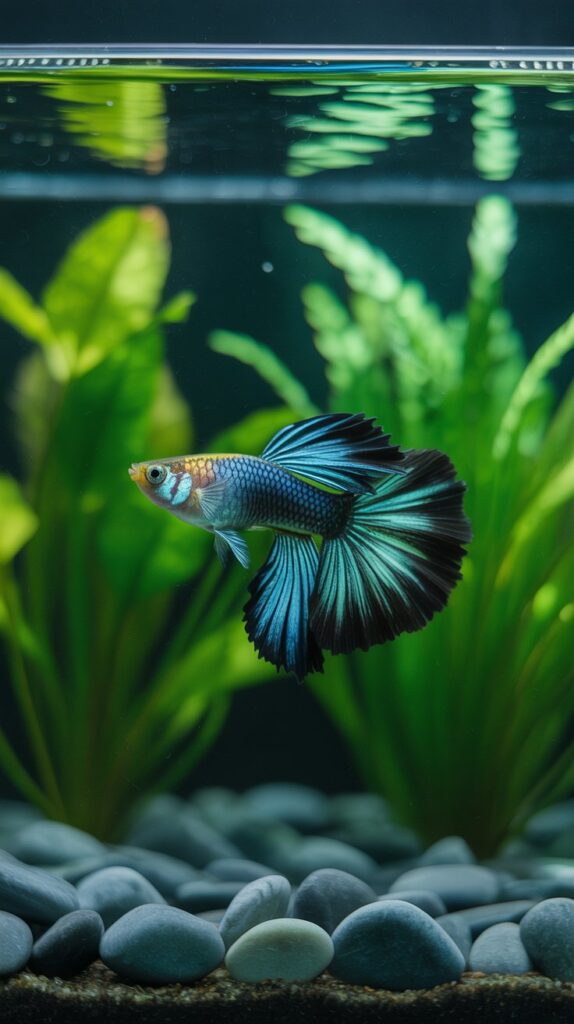
Although guppies are hardy, proper tank conditions are important for their health and coloration.
Minimum Tank Size:
- 5 gallons for a trio (1 male, 2 females)
- 10–20 gallons recommended for a larger community
Water Parameters:
- Temperature: 72–82°F (22–28°C)
- pH: 6.8–7.8
- Hardness: 8–12 dGH
- Filtration: Gentle sponge filter or low-flow internal filter
Aquascaping Tips:
- Provide live plants like Java Moss, Anubias, and Hornwort for hiding and breeding.
- Keep open swimming areas for active movement.
- Use a dark substrate to enhance the contrast of their colors.
6. Diet and Feeding
Half Black Guppies are omnivores and thrive on a varied diet.
Recommended Foods:
- High-Quality Flake Food (specifically for guppies or tropical fish)
- Live Foods: Daphnia, baby brine shrimp, mosquito larvae
- Frozen Foods: Bloodworms, tubifex
- Vegetables: Blanched spinach, cucumber, zucchini (once a week)
Feeding Frequency: 2–3 times a day in small portions to prevent overfeeding.
7. Breeding Half Black Guppies
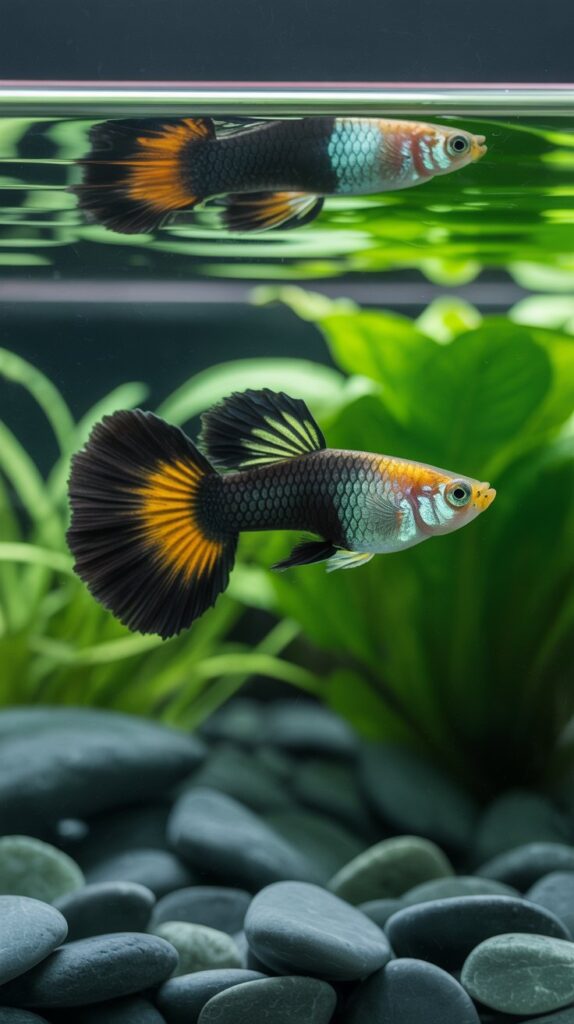
Breeding guppies is famously easy, and Half Black Guppies are no exception.
Steps for Successful Breeding:
- Ratio: Keep 1 male for every 2–3 females to reduce stress.
- Breeding Tank: Use a separate 5–10 gallon tank with fine-leaved plants.
- Gestation Period: Around 21–30 days.
- Fry Care: Move fry to a separate nursery tank to prevent them from being eaten. Feed with infusoria or crushed flakes.
Tip: For the deepest black color in offspring, breed from parents with intense pigmentation.
8. Common Health Issues
While Half Black Guppies are hardy, they are prone to a few common fish diseases:
- Ich (White Spot Disease): Appears as small white dots; treat with aquarium salt and temperature increase.
- Fin Rot: Often caused by poor water quality; improve filtration and treat with antibacterial medicine.
- Swim Bladder Disease: Avoid overfeeding and feed high-fiber foods.
Prevention Tip: Maintain clean water, avoid sudden temperature changes, and quarantine new fish.
9. Suitable Tank Mates
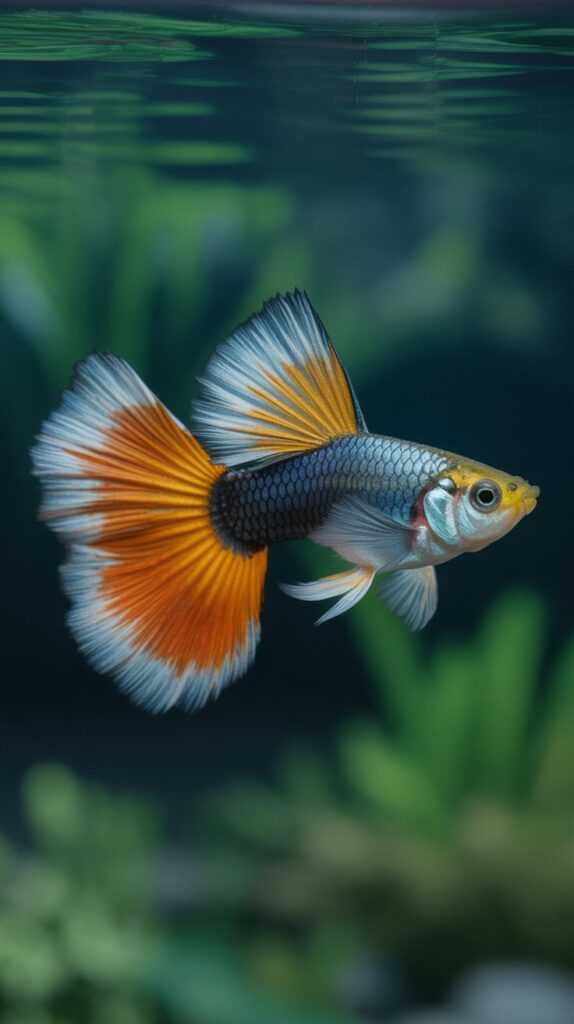
Half Black Guppies do well with other peaceful species, including:
- Neon Tetras
- Corydoras Catfish
- Platies
- Mollies
- Harlequin Rasboras
Avoid aggressive or fin-nipping fish like Tiger Barbs or large Cichlids.
10. Why Choose Half Black Guppies?
- Striking, unique coloration
- Easy to breed
- Hardy and adaptable
- Active and peaceful nature
- Ideal for both beginners and advanced aquarists
11. Tips for Maintaining Vibrant Colors
- Provide a balanced diet with color-enhancing foods.
- Keep stress low by avoiding overcrowding.
- Ensure good lighting to bring out their natural beauty.
- Regular water changes (25–30% weekly).
12. Conclusion
The Half Black Guppy is a perfect blend of elegance and ease of care. Its contrasting colors make it one of the most sought-after guppy varieties among aquarium enthusiasts. With proper care, diet, and breeding conditions, these guppies will thrive and add unmatched beauty to your tank for years to come.
FAQs About Half Black Guppies
Q1: How long do Half Black Guppies live?
A: Typically, 2–3 years with good care and stable water conditions.
Q2: Are Half Black Guppies beginner-friendly?
A: Yes! They are hardy, adaptable, and easy to breed.
Q3: How many Half Black Guppies should I keep together?
A: A small group of 6 or more will make them feel secure and encourage natural behavior.
Q4: Can Half Black Guppies live with Betta fish?
A: It depends on the Betta’s temperament. Peaceful Bettas can cohabit, but aggressive ones may nip guppy fins.
Q5: How can I make the black color more intense?
A: Provide high-quality food, avoid inbreeding, and maintain good water quality.

